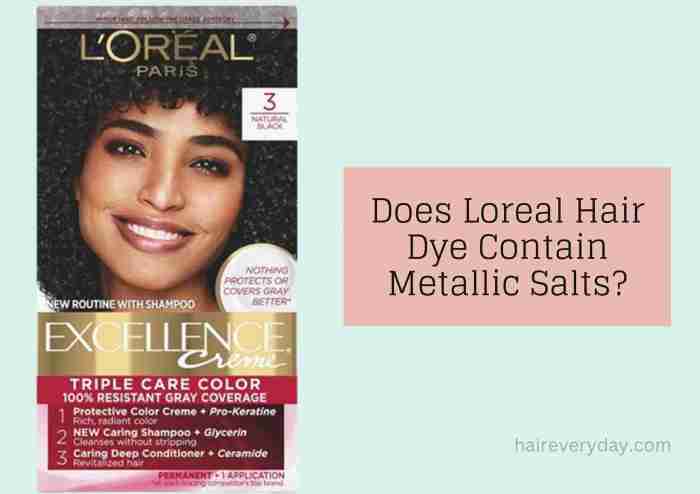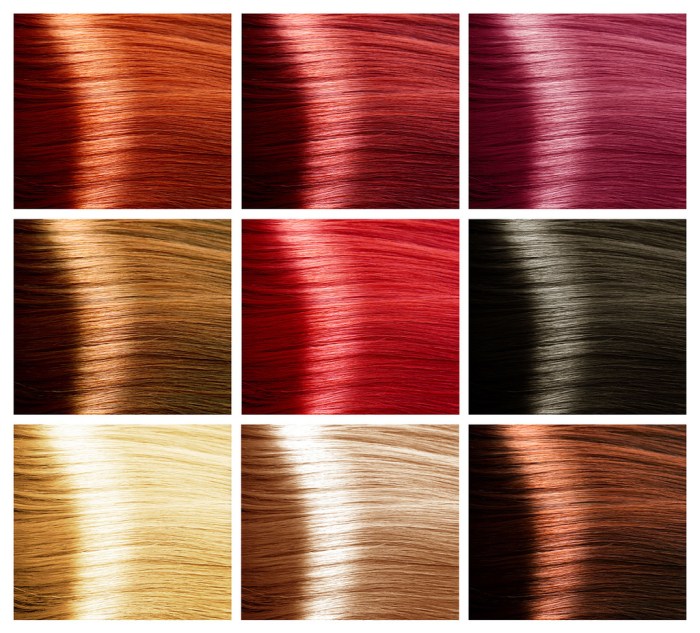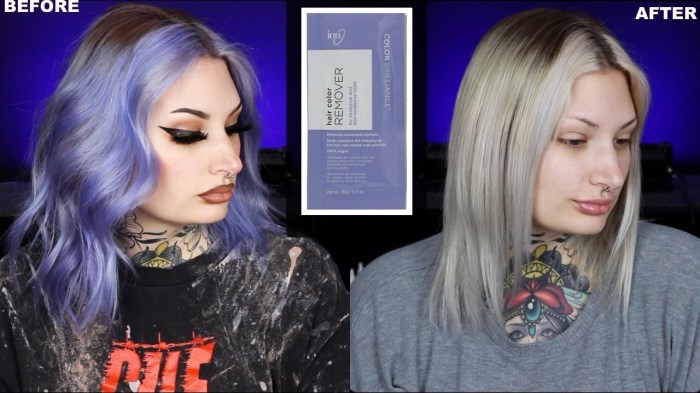Metallic salts in hair dye have revolutionized the hair coloring industry, offering vibrant and long-lasting hues. But with their use comes a myriad of considerations, from safety to alternatives. Let’s delve into the world of metallic salts in hair dye, exploring their types, mechanisms, and the crucial factors to keep in mind.
Metallic salts, such as lead, copper, and bismuth, react with hair proteins to create colorful pigments. These pigments penetrate the hair shaft, resulting in intense and durable coloration. However, their potential risks and side effects demand careful attention.
Types of Metallic Salts Used in Hair Dye

Metallic salts are inorganic compounds that have been used for centuries to color hair. They are typically composed of a metal ion and an anion, and they can be either natural or synthetic.
The most common metallic salts used in hair dye are:
- Lead acetate
- Copper acetate
- Iron oxide
- Silver nitrate
Each of these metallic salts has its own unique properties and effects on hair.
Lead Acetate
Lead acetate is a white or colorless solid that is soluble in water. It has been used as a hair dye for centuries, and it is still used today to create black or brown hair.
Lead acetate is a toxic substance, and it can be harmful if it is ingested or absorbed through the skin. It can cause a variety of health problems, including kidney damage, brain damage, and cancer.
Copper Acetate, Metallic salts in hair dye
Copper acetate is a green or blue solid that is soluble in water. It has been used as a hair dye for centuries, and it is still used today to create green or blue hair.
Copper acetate is a less toxic substance than lead acetate, but it can still be harmful if it is ingested or absorbed through the skin. It can cause a variety of health problems, including skin irritation, eye irritation, and respiratory problems.
Iron Oxide
Iron oxide is a red or brown powder that is insoluble in water. It has been used as a hair dye for centuries, and it is still used today to create red or brown hair.
Iron oxide is a non-toxic substance, and it is safe to use as a hair dye.
Silver Nitrate
Silver nitrate is a white or colorless solid that is soluble in water. It has been used as a hair dye for centuries, and it is still used today to create blonde or gray hair.
Silver nitrate is a toxic substance, and it can be harmful if it is ingested or absorbed through the skin. It can cause a variety of health problems, including skin irritation, eye irritation, and respiratory problems.
Mechanisms of Action

Metallic salts in hair dye undergo chemical reactions with the hair’s natural components, leading to hair coloration. These reactions involve the oxidation of melanin, the pigment responsible for hair color, and the formation of new colored compounds.
Oxidation of Melanin
Metallic salts act as oxidizing agents, reacting with melanin and breaking down its structure. This process lightens the hair by reducing the amount of melanin present. The extent of lightening depends on the concentration of the metallic salt and the duration of the treatment.
Formation of New Colored Compounds
Metallic salts also form new colored compounds with the hair’s amino acids and proteins. These compounds absorb light at specific wavelengths, giving the hair its desired color. The type of metallic salt used determines the resulting color, with different salts producing different shades of brown, red, or black.
Factors Influencing Hair Color
The intensity and duration of hair color achieved with metallic salts depend on several factors:
-
-*Hair porosity
Porous hair absorbs more metallic salts, resulting in more intense and longer-lasting color.
-*Hair texture
Fine hair absorbs metallic salts more easily than coarse hair, leading to more vibrant color.
-*Concentration of metallic salt
Higher concentrations of metallic salts produce darker and more permanent color.
-*Treatment time
Longer treatment times allow for greater penetration of metallic salts and more intense color.
Safety and Health Considerations

The use of metallic salts in hair dye is not without potential risks and side effects. These include skin irritation, allergic reactions, and hair damage. In some cases, metallic salts can even lead to more serious health problems, such as kidney damage and cancer.
To ensure the safe use of hair dye containing metallic salts, several regulations and guidelines have been put in place. These regulations vary from country to country, but they typically include limits on the concentration of metallic salts that can be used in hair dye products.
They also require manufacturers to provide clear and accurate labeling on their products, so that consumers can make informed decisions about whether or not to use them.
Minimizing Risks
There are several things that consumers can do to minimize the risks associated with hair dye containing metallic salts. These include:
- Read the label carefully before using any hair dye product.This will help you to understand the potential risks and side effects of the product, and to make an informed decision about whether or not to use it.
- Do a patch test before using any hair dye product.This will help you to determine if you are allergic to any of the ingredients in the product.
- Follow the instructions on the product label carefully.This will help you to use the product safely and effectively.
- Avoid using hair dye products that contain metallic salts if you have sensitive skin or a history of allergic reactions.
- Rinse your hair thoroughly after using any hair dye product.This will help to remove any residual metallic salts from your hair.
Alternatives to Metallic Salts: Metallic Salts In Hair Dye

Metallic salts have been widely used in hair dyeing for centuries, but they come with certain drawbacks. Fortunately, several alternative hair dyeing methods offer comparable results without the potential health risks associated with metallic salts.
Natural Dyes
Natural dyes, such as henna, indigo, and madder root, have been used for hair coloring for millennia. They are derived from plants and contain pigments that bind to the hair’s keratin, resulting in long-lasting color. Natural dyes are generally considered safer than metallic salts and can provide rich, vibrant shades.
Metallic salts are commonly used in hair dyes to impart various colors. These salts react with the hair’s natural pigments to produce the desired shade. While metallic salts can enhance the appearance of hair, it’s crucial to be aware of the potential risks associated with their use.
For a comprehensive understanding of the effects of metallic salts on hair dye, consider referring to the qmb 3200 ucf final exam resource. This resource provides detailed information on the topic, ensuring you make informed decisions regarding the use of metallic salts in hair dyes.
- Advantages:Safe, eco-friendly, can condition hair, semi-permanent.
- Disadvantages:Limited color range, can be time-consuming to apply, may require multiple applications to achieve desired results.
- Suitability:Best for natural or slightly processed hair, not recommended for drastically color-treated hair.
Semi-Permanent Dyes
Semi-permanent dyes are a less invasive option than metallic salts. They contain smaller molecules that penetrate the hair shaft but do not permanently alter its structure. Semi-permanent dyes typically last for 6-8 washes and offer a wide range of colors.
- Advantages:Gentle on hair, vibrant colors, easy to apply, fades gradually.
- Disadvantages:Not as long-lasting as metallic salts, may require frequent touch-ups.
- Suitability:Suitable for all hair types, especially those that are damaged or prone to breakage.
Direct Dyes
Direct dyes are another type of temporary hair dye that deposits color directly onto the hair’s surface without penetrating the shaft. They are typically used to enhance or refresh existing hair color and can be easily applied at home.
- Advantages:Quick and easy to use, no mixing required, fade quickly.
- Disadvantages:Not as long-lasting as semi-permanent dyes, can stain skin and clothing.
- Suitability:Ideal for quick color changes or touch-ups, not suitable for drastic color transformations.
Other Alternatives
In addition to the above methods, other alternatives to metallic salts include:
- Hair chalk:A temporary colorant that can be applied directly to hair, easily washed out with water.
- Color-depositing shampoos and conditioners:Enhance or refresh existing hair color with each use.
- Hair masks:Some hair masks contain natural pigments that can subtly alter hair color.
Innovations and Trends

The hair dyeing industry is constantly evolving, with new trends and innovations emerging regularly. Metallic salts continue to play a significant role in hair dyeing, and there are several exciting developments in this area.
One of the key trends is the development of new formulations that enhance safety and efficacy. Traditional metallic salts can be harsh on the hair, causing damage and irritation. However, new formulations are being developed that minimize these side effects while still providing vibrant and long-lasting color.
New Technologies
Another trend is the use of new technologies to improve the application and performance of metallic salts. For example, some hair dyes now use nanotechnology to deliver metallic salts more effectively to the hair shaft. This results in more even coverage and longer-lasting color.
Future of Metallic Salts
Metallic salts are likely to remain an important part of the hair dyeing industry for the foreseeable future. However, the development of new formulations and technologies will continue to shape the way they are used. In the future, we can expect to see even safer and more effective metallic salt-based hair dyes that provide beautiful and long-lasting color.
Q&A
What are the common types of metallic salts used in hair dye?
Lead acetate, copper sulfate, and bismuth citrate are frequently employed in hair dyes.
How do metallic salts achieve hair coloration?
They react with hair proteins, forming pigments that penetrate the hair shaft.
Are there any safety concerns associated with metallic salts in hair dye?
Yes, some metallic salts can cause skin irritation, allergic reactions, and even hair damage.
What are the alternatives to metallic salts for hair dyeing?
Plant-based dyes, henna, and synthetic dyes offer alternative hair coloring options.
